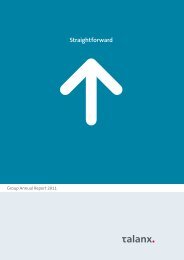ONE ROOF
ONE ROOF
ONE ROOF
Create successful ePaper yourself
Turn your PDF publications into a flip-book with our unique Google optimized e-Paper software.
Budapest Airport<br />
HOCHTIEF AirPort stake: 37.25%<br />
During the reporting year, Budapest Airport handled<br />
fewer passengers than in the same prior-year period.<br />
The number of passengers dropped by 4.1 percent to<br />
8.1 million. This result was better on the whole than<br />
that of the comparable regional airports in Vienna,<br />
Prague and Warsaw.<br />
The airport is optimally prepared to process increasing<br />
traffic volumes when the general economic situation<br />
improves again. The work for the BUD Future modernization<br />
program launched in 2007 is proceeding, and<br />
important milestones were reached in the past fiscal<br />
year. In June 2009, the foundation stone was laid for<br />
the BUD SkyCourt. This building will link Terminals 2A<br />
and 2B and provide space for retail, catering outlets<br />
and lounges, thus contributing to a boost in non-aviation<br />
income. In addition, a new organizational structure<br />
with profit and cost centers was introduced in order to<br />
further optimize processes in the airport company and<br />
more consistently position the company to meet market<br />
requirements.<br />
In view of the difficult financial situation at Hungarian<br />
airline Malév, which failed to make some of the payments<br />
due to Budapest Airport in November 2009, the<br />
airport company in Budapest initiated measures to protect<br />
its interests, including in the event that payments<br />
are suspended for an extended period. Currently, Malév’s<br />
shareholders are working on plans to stabilize the airline<br />
for the long term.<br />
Düsseldorf International<br />
HOCHTIEF AirPort stake: 20% / HOCHTIEF AirPort Capital stake: 10%<br />
Passenger figures at Düsseldorf Airport contracted by<br />
two percent in 2009 to 17.8 million. Despite the general<br />
mood of economic restraint, the number of transfer<br />
passengers increased sharply again in 2009. The airport<br />
company launched an investment program totaling<br />
around EUR 300 million as early as 2008 as a reaction<br />
to the growing amount of hub traffic generated by<br />
the two key airlines in Düsseldorf—Air Berlin and Lufthansa.<br />
Rapid-access routes enable air passengers to<br />
quickly transfer between flights. Transfer facilities are<br />
being set up at boarding gate A, and a new airside link<br />
❘ Information for our Shareholders ❘ ❘ Management Report ❘ ❘ Financial Statements and Notes ❘<br />
will connect boarding gates B and C in the future. Düs-<br />
seldorf Airport thus reinforced its position as the third<br />
largest airport in Germany, developed into a major<br />
regional hub and made travel more comfortable for its<br />
passengers.<br />
The legal dispute with neighbors of the airport concern-<br />
ing its operating permit was brought to a close during<br />
the year under review. A final judgment was rendered<br />
by the Higher Administrative Court in Münster in July<br />
2009 ruling out any further appeals. For Düsseldorf<br />
International, this development makes its planning more<br />
dependable: As stipulated by the permit, the airport is<br />
allowed 131,000 starts and landings in the six heaviesttraffic<br />
months of the year.<br />
The marketing of Airport City, a service center directly<br />
adjacent to the terminals, continues to meet with success.<br />
More than half of the plots have been sold to users<br />
and investors, and most of these are already being<br />
developed. The initial segment of around one third of<br />
the total area has already been completed. The airport<br />
believes that the entire property will be sold to investors<br />
by 2016.<br />
Hamburg Airport<br />
HOCHTIEF AirPort stake: 34.8% / HOCHTIEF AirPort Capital stake: 14.2%<br />
Hamburg Airport handled 12.2 million passengers dur-<br />
ing the period under review, 4.7 percent fewer than in<br />
the prior year. The number decreased due to the financial<br />
crisis here as well, but in November and December<br />
the airport again experienced slight growth.<br />
A lively non-aviation business stood in contrast to the<br />
restraint in the aviation segment: At the end of October,<br />
the Radisson Blu Hotel opened its doors across from<br />
the terminals and Airport Plaza. The hotel is connected<br />
directly with the departures and arrivals areas of the<br />
terminals and makes Hamburg Airport an even more<br />
attractive location for events. In total, the 226-room facility<br />
features 15 multi-function meeting and conference<br />
rooms. Moreover, the parking areas were also expanded.<br />
The airport now offers more than 12,000 parking spaces<br />
with a new parking deck in the P2-P4 complex.<br />
Annual Report 2009 93
















